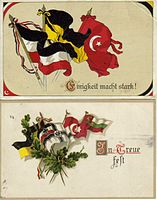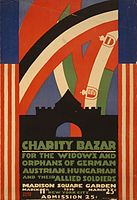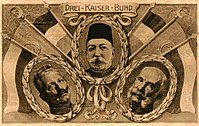Central Powers
Central Powers | |||||||||||||
|---|---|---|---|---|---|---|---|---|---|---|---|---|---|
| 1914–1918 | |||||||||||||
 The Central Powers as of 14 October 1915 | |||||||||||||
| Status | Military alliance | ||||||||||||
| Membership |
| ||||||||||||
| Historical era | World War I | ||||||||||||
• Established | 1914 | ||||||||||||
• Dissolved | 1918 | ||||||||||||
| |||||||||||||
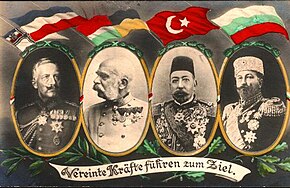
- Leaders of the Central Powers (left to right):
- Kaiser Wilhelm II of Germany;
- Kaiser and King Franz Joseph of Austria-Hungary;
- Sultan Mehmed V of the Ottoman Empire;
- Tsar Ferdinand I of Bulgaria
- The caption reads:
- "Vereinte Kräfte führen zum Ziel"
- ("United Powers Lead to the Goal")
The Central Powers, also known as the Central Empires,[1][notes 1] were one of the two main coalitions that fought in World War I (1914–1918). It consisted of the German Empire, Austria-Hungary, the Ottoman Empire, and Bulgaria; this was also known as the Quadruple Alliance.[2][notes 2]
The Central Powers' origin was the alliance of Germany and Austria-Hungary in 1879. Despite having nominally joined the Triple Alliance before, Italy did not take part in World War I on the side of the Central Powers and later joined on the side of the Allied Powers. The Ottoman Empire and Bulgaria did not join until after World War I had begun. The Central Powers faced, and were defeated by, the Allied Powers, which themselves had formed around the Triple Entente. They dissolved in 1918 after they lost the war.
Name
[edit]The name Central Powers is derived from the location of its member countries; all four were located between the Russian Empire in the east and France and the United Kingdom in the west.[3]
Collaboration
[edit]Germany had plans to create a Mitteleuropa economic association. Members would include Austria-Hungary, Germany, and others.[4]
History
[edit]Archduke Franz Ferdinand of Austria, heir presumptive to the Austro-Hungarian throne, and his wife, Sophie, Duchess of Hohenberg, were assassinated on 28 June 1914 by Bosnian Serb student Gavrilo Princip.[5] This provoked Austria to deliver an ultimatum to Serbia, listing ten demands made intentionally unacceptable to provide an excuse for starting hostilities.[6] Serbia ordered general mobilization on 25 July, but accepted almost all of the terms, the only ones not accepted were the ones empowering Austrian representatives to suppress "subversive elements" in Serbia, and to take part in the investigation and trial of Serbians linked to the assassination.[7] After claiming that was rejection, Austria broke off diplomatic relations with Serbia. They then declared war and began shelling Belgrade. Russia ordered general mobilization in support of Serbia on 30 July.[8] When Russia mobilized, Germany saw it as provocative. Despite Russia's claim that it was responding to the events in Serbia and not Germany, Germany dismissed this and mobilized as well. Later, France, allied with Russia, also mobilized.[9] On 29 October 1914, the Ottoman Empire entered the war by launching a naval raid on Russian ports.[10][11] Bulgaria joined the Central Powers last, which it did in October 1915 by declaring war on Serbia.[12]
Main member states
[edit]At the start of the war, the Central Powers consisted of the German Empire and the Austro-Hungarian Empire. The Ottoman Empire joined later in 1914, followed by the Tsardom of Bulgaria in 1915.[3]
| Nation | Date of entry |
|---|---|
| 28 July 1914 | |
| 1 August 1914 | |
| 2 August 1914, announced 29 October 1914 | |
| 14 October 1915 |
German Empire
[edit]War justifications
[edit]

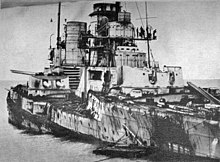
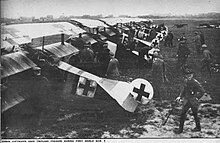
In early July 1914, in the aftermath of the assassination of Austro-Hungarian Archduke Franz Ferdinand and faced with the prospect of war between Austria-Hungary and Serbia, Kaiser Wilhelm II and the German government informed the Austro-Hungarian government that Germany would uphold its alliance with Austria-Hungary and defend it from possible Russian intervention if a war between Austria-Hungary and Serbia took place.[13] When Russia enacted a general mobilization, Germany viewed the act as provocative.[14]: 39 The Russian government promised Germany that its general mobilization did not mean preparation for war with Germany but was a reaction to the tensions between Austria-Hungary and Serbia.[14]: 39 The German government regarded the Russian promise of no war with Germany to be nonsense in light of its general mobilization, and Germany, in turn, mobilized for war.[14]: 39 On 1 August, Germany sent an ultimatum to Russia stating that since both Germany and Russia were in a state of military mobilization, an effective state of war existed between the two countries.[14]: 95 Later that day, France, an ally of Russia, declared a state of general mobilization.[14]: 95
In August 1914, Germany attacked Russia, citing Russian aggression as demonstrated by the mobilization of the Russian army, which had resulted in Germany mobilizing in response.[15]
After Germany declared war on Russia, France, with its alliance with Russia, prepared a general mobilization in expectation of war. On 3 August 1914, Germany responded to this action by declaring war on France.[16] Germany, facing a two-front war, enacted what was known as the Schlieffen Plan, which involved German armed forces moving through Belgium and swinging south into France and towards the French capital of Paris. This plan was hoped to quickly gain victory against the French and allow German forces to concentrate on the Eastern Front. Belgium was a neutral country and would not accept German forces crossing its territory. Germany disregarded Belgian neutrality and invaded the country to launch an offensive towards Paris. This caused Great Britain to declare war against the German Empire, as the action violated the Treaty of London that both nations signed in 1839 guaranteeing Belgian neutrality.[17]
Subsequently, several states declared war on Germany in late August 1914, with Italy declaring war on Germany in August 1916,[18] the United States in April 1917,[19] and Greece in July 1917.[20]
Colonies and dependencies
[edit]Europe
[edit]The German Empire had incorporated the province of Alsace-Lorraine, after successfully defeating France in the Franco-Prussian War. However, the province was still claimed by French revanchists,[21][22] leading to its return to France at the Treaty of Versailles.[23]
Africa
[edit]The German Empire was late to colonization, only beginning overseas expansion in the 1870s and 1880s. Colonization was opposed by much of the government, including chancellor Otto von Bismarck, but it became a colonial power after participating in the Berlin Conference. Then, private companies were founded and began settling parts of Africa, the Pacific, and China. Later these groups became German protectorates and colonies.[24]
Cameroon was a German colony existing from 1884 until its complete occupation in 1915. It was ceded to France as a League of Nations Mandate at the war's end.[25]
German East Africa was founded in 1885 and expanded to include modern-day Tanzania (except Zanzibar), Rwanda, Burundi, and parts of Mozambique. It was the only German colony to not be fully conquered during the war, with resistance by commander Paul von Lettow-Vorbeck lasting until November 1918. Later it was surrendered to the Allies in 1919 and split between the Belgian Congo, Portuguese Mozambique, and the newly founded colony of Tanganyika.[26]
South West Africa, modern-day Namibia, came under German rule in 1885 and was absorbed into South Africa following its invasion in 1915.[27]
Togoland, now part of Ghana, was made a German protectorate in 1884. However, after a swift campaign, it was occupied by the Allies in 1915 and divided between French Togoland and British Togoland.[28]
Asia
[edit]The Jiaozhou Bay Leased Territory was a German dependency in East Asia leased from China in 1898.[29] Japanese forces occupied it following the Siege of Tsingtao.[30]
The Austrian Empire had a foreign concession in Tianjin which was swiftly invaded by China in 1917. The German concessions in Tianjin and Hankou were also invaded.[31]
Pacific
[edit]German New Guinea was a German protectorate in the Pacific. It was occupied by Australian forces in 1914.[32]
German Samoa had been a German protectorate since the Tripartite Convention.[33] It was occupied by the New Zealand Expeditionary Force in 1914.[34]
Austro-Hungarian Empire
[edit]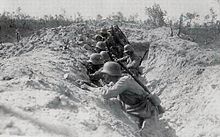
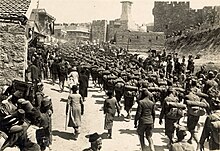
War justifications
[edit]Austria-Hungary regarded the assassination of Archduke Franz Ferdinand as having been orchestrated with the assistance of Serbia.[13] The country viewed the assassination as setting a dangerous precedent of encouraging the country's South Slav population to rebel and threaten to tear apart the multinational country.[14]: 39 Austria-Hungary sent a formal ultimatum to Serbia demanding a full-scale investigation of Serbian government complicity in the assassination and complete compliance by Serbia in agreeing to the terms demanded by Austria-Hungary.[13] Serbia submitted to accept most of the demands. However, Austria-Hungary viewed this as insufficient and used this lack of full compliance to justify military intervention.[13] These demands have been viewed as a diplomatic cover for an inevitable Austro-Hungarian declaration of war on Serbia.[13]
Russia had warned Austria-Hungary that the Russian government would not tolerate Austria-Hungary invading Serbia.[13] However, with Germany supporting Austria-Hungary's actions, the Austro-Hungarian government hoped that Russia would not intervene and that the conflict with Serbia would remain a regional conflict.[13]
Austria-Hungary's invasion of Serbia resulted in Russia declaring war on the country, and Germany, in turn, declared war on Russia, setting off the beginning of the clash of alliances that resulted in the World War.[35]
Territory
[edit]Austria-Hungary was internally divided into two states with their own governments, joined through the Habsburg throne. Austria, also known as Cisleithania, contained various duchies and principalities but also the Kingdom of Bohemia,[36] the Kingdom of Dalmatia,[37] and the Kingdom of Galicia and Lodomeria.[38] Hungary (Transleithania) was composed of the Kingdom of Hungary[39] and the Kingdom of Croatia-Slavonia.[40] In Bosnia and Herzegovina, sovereign authority was shared by both Austria and Hungary.[41]
Ottoman Empire
[edit]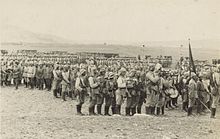
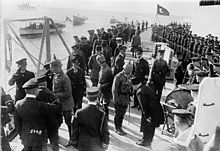
War justifications
[edit]The Ottoman Empire joined the war on the side of the Central Powers in November 1914. The Ottoman Empire had gained strong economic connections with Germany through the Berlin-to-Baghdad railway project that was still incomplete at the time.[42] The Ottoman Empire made a formal alliance with Germany signed on 2 August 1914.[43]: 292 The alliance treaty expected that the Ottoman Empire would become involved in the conflict in a short amount of time.[43]: 292 However, for the first several months of the war, the Ottoman Empire maintained neutrality though it allowed a German naval squadron to enter and stay near the strait of Bosphorus.[44] Ottoman officials informed the German government that the country needed time to prepare for conflict.[44] Germany provided financial aid and weapons shipments to the Ottoman Empire.[43]: 292
After pressure escalated from the German government demanding that the Ottoman Empire fulfill its treaty obligations, or else Germany would expel the country from the alliance and terminate economic and military assistance, the Ottoman government entered the war with the recently acquired cruisers from Germany, along with their own navy, launching a naval raid on the Russian ports of Odessa, Sevastopol, Novorossiysk, Feodosia, and Yalta,[10][11] thus engaging in military action in accordance with its alliance obligations with Germany. Shortly after, the Triple Entente declared war on the Ottoman Empire.[43]: 293
Bulgaria
[edit]War justifications
[edit]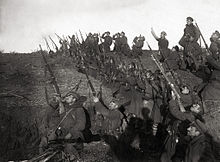
After Bulgaria's defeat in July 1913 at the hands of Serbia, Greece and Romania, it signed a treaty of defensive alliance with the Ottoman Empire on 19 August 1914.[45] Bulgaria was the last country to join the Central Powers, which it did in October 1915 by declaring war on Serbia.[12] It invaded Serbia in conjunction with German and Austro-Hungarian forces.[46]
Bulgaria held claims on the region of Vardar Macedonia then held by Serbia following the Balkan Wars of 1912–1913 and the Treaty of Bucharest (1913).[47] As a condition of entering the war on the side of the Central Powers, Bulgaria was granted the right to reclaim that territory.[48][49]
Co-belligerents
[edit]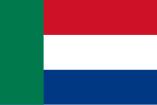
South African Republic
[edit]In opposition to offensive operations by Union of South Africa, which had joined the war, Boer army officers of what is now known as the Maritz Rebellion "refounded" the South African Republic in September 1914. Germany assisted the rebels, with some operating in and out of the German colony of German South-West Africa. The rebels were all defeated or captured by South African government forces by 4 February 1915.[50]
Senussi Order
[edit]
The Senussi Order was a Muslim political-religious tariqa (Sufi order) and clan in Libya, previously under Ottoman control, which had been lost to Italy in 1912.[51] In 1915, they were courted by the Ottoman Empire and Germany, and Grand Senussi Ahmed Sharif as-Senussi declared jihad and attacked the Italians in Libya and the British in Egypt in the Senussi Campaign.[52]
Sultanate of Darfur
[edit]
In 1915, the Sultanate of Darfur renounced allegiance to the Sudanese government and aligned with the Ottomans. They were able to contact them via the Senussi. Prior to this they were a British ally. The Anglo-Egyptian Darfur Expedition preemptively invaded to prevent an attack on Sudan.[53] A small force was sent after the sultan and he was killed in action in November 1916.[54] The invasion ended with an Anglo-Egyptian victory in November 1916.[53]
Zaian Confederation
[edit]The Zaian Confederation began to fight against France in the Zaian War to prevent French expansion into Morocco.[55] The fighting lasted from 1914 and continued after the First World War ended, to 1921. The Central Powers (mainly the Germans) began to attempt to incite unrest to hopefully divert French resources from Europe.[56]
Dervish State
[edit]
The Dervish State fought against the British, Ethiopian, Italian, and French Empires between 1896 and 1925.[57] During World War I, the Dervish State received many supplies from the German and Ottoman Empires to carry on fighting the Allies. However, looting from other Somali tribes in the Korahe raid eventually led to its collapse in 1925.[58][59][60][61]
Client states
[edit]Both the Ottomans and Germans had client states, they are listed below.
Nations supported by the Central Powers
[edit]States listed in this section were not officially members of the Central Powers. Still, during the war, they cooperated with one or more Central Powers members on a level that makes their neutrality disputable.
Ethiopia
[edit]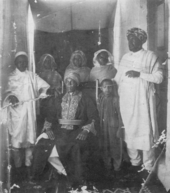
The Ethiopian Empire was officially neutral throughout World War I but widely suspected of sympathy for the Central Powers between 1915 and 1916. At the time, Ethiopia was one of only two fully independent states in Africa (the other being Liberia) and a major power in the Horn of Africa. Its ruler, Lij Iyasu, was widely suspected of harbouring pro-Islamic sentiments and being sympathetic to the Ottoman Empire.[75] The German Empire also attempted to reach out to Iyasu, dispatching several unsuccessful expeditions to the region to attempt to encourage it to collaborate in an Arab Revolt-style uprising in East Africa. One of the unsuccessful expeditions was led by Leo Frobenius, a celebrated ethnographer and personal friend of Kaiser Wilhelm II. Under Iyasu's directions, Ethiopia probably supplied weapons to the Muslim Dervish rebels during the Somaliland Campaign of 1915 to 1916, indirectly helping the Central Powers' cause.[76]
The Allies jointly pressured the aristocracy for the designated emperor's removal on the 10th of September, 1916 stating he was a threat to both the Allies and Ethiopia.[77] Fearing the rising influence of Iyasu and the Ottoman Empire, the Christian nobles of Ethiopia conspired against Iyasu. Iyasu was first excommunicated by the Ethiopian Orthodox Patriarch and eventually deposed in a coup d'état on 27 September 1916. A less pro-Ottoman regent, Ras Tafari Makonnen, was installed on the throne.[76]
Liechtenstein
[edit]
Liechtenstein was officially neutral throughout World War I, though the general population and government was supportive of the Central Powers, particularly Austria-Hungary, of which the two countries had been in a customs union since 1852. However, from September 1914 food deliveries from Austria-Hungary began to decrease, which quickly soured the initial war support.[78] By 1916 all food deliveries from Austria-Hungary had ceased, which forced Liechtenstein to seek closer ties with Switzerland in order to ensure food deliveries continued.[78][79] From 1916, Liechtenstein was embargoed by the Entente countries due to their connections to the Central Powers, which caused mass unemployment in the country.[80] The government remained sympathetic to the Central Powers until 7 November 1918, when the November 1918 Liechtenstein putsch took place and a new government took power.[81]
Upper Asir
[edit]Upper Asir, a sheikdom in Arabia, revolted away from Asir in 1916, possibly with Hejazi aid.[82] It was led by Hassan bin Ali al-Aidh.[83] It was then partitioned between the Saudi and the Idrisi on 30 August 1920.[82]
Kingdom of Greece
[edit]The Kingdom of Greece was in a political dispute with Venizelists. The Central Powers supported the royalists until King Constantine's abdication in 1917.[84]
Romania
[edit]Following their armistice with the Central Powers, Romania was involved in the Russian Civil War against both the Whites and the Reds. Romania fought alongside the Central Powers until it rejoined the war against them on November 10, 1918.[85]
Kelantan
[edit]Kelantanese rebels were supported by the Ottoman and German Empires during their anti-colonial uprising against the British Empire in 1915.[86]
Non-state combatants
[edit]Other movements supported the efforts of the Central Powers for their own reasons, such as the radical Irish Nationalists who launched the Easter Rising in Dublin in April 1916; they referred to their "gallant allies in Europe". However, most Irish Nationalists supported the British and allied war effort up until 1916, when the Irish political landscape was changing. In 1914, Józef Piłsudski was permitted by Germany and Austria-Hungary to form independent Polish legions. Piłsudski wanted his legions to help the Central Powers defeat Russia and then side with France and the UK and win the war with them.[87] Below is a list of these non-state combatants.
Armistice and treaties
[edit]Bulgaria signed an armistice with the Allies on 29 September 1918, following a successful Allied advance in Macedonia.[93] The Ottoman Empire followed suit on 30 October 1918 in the face of British and Arab gains in Palestine and Syria.[94] Austria and Hungary concluded ceasefires separately during the first week of November following the disintegration of the Habsburg Empire and the Italian offensive at Vittorio Veneto;[95][96] Germany signed the armistice ending the war on the morning of 11 November 1918 after the Hundred Days Offensive, and a succession of advances by New Zealand, Australian, Canadian, Belgian, British, French and US forces in north-eastern France and Belgium. There was no unified treaty ending the war; the Central Powers were dealt with in separate treaties.[97]
|
| |||||||||||||||||||||||||||||||||||||||||||||||||
-
A postcard depicting the flags of the Central Powers' countries
-
Poster for a 1916 charity bazaar raising funds for widows and orphans of the Central Power states
-
The leaders of the Central Powers in 1914
Leaders
[edit]Below is a table of the leaders of the Central Powers.
| Portrait | Leader | Title | Time period |
|---|---|---|---|
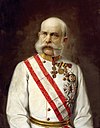
|
Franz Joseph I[98] | Emperor of Austria and Apostolic King of Hungary | 1848–1916 |

|
Karl I[98] | Emperor of Austria and Apostolic King of Hungary | 1916–1918 |

|
Wilhelm II[98] | German Emperor | 1888–1918 |

|
Mehmed V[98] | Sultan of the Ottoman Empire | 1909–1918 |

|
Mehmed VI[98] | Sultan of the Ottoman Empire | 1918–1922 |

|
Ferdinand I[99] | Tsar of Bulgaria | 1887–1918 |
| Ali Dinar[100] | Sultan of Darfur | 1899–1916 | |

|
Manie Maritz[101] | Leader of the Maritz Rebellion | 1914–1915 |

|
Mohammed Abdullah Hassan[102] | Emir of the Dervish State | 1896–1920 |

|
Ahmed Sharif as-Senussi[103] | Leader of the Senussi | 1902–1933 |

|
Saud bin Abdulaziz[104] | Emir of Jabal Shammar | 1908–1920 |

|
Fatali Khan Khoyski[105] | Prime Minister of Azerbaijan | 1918–1919 |
| Pavlo Skoropadskyi[106] | Hetman of Ukraine | 1918–1918 |
Statistics
[edit]
| Country | Population (millions) |
Land (million km2) |
GDP ($ billion) |
GDP per capita ($) | |
|---|---|---|---|---|---|
| Mainland | 67.0 | 0.5 | 244.3 | 3,648 | |
| Colonies | 10.7 | 3.0 | 6.4 | 601 | |
| Total | 77.7 | 3.5 | 250.7 | 3,227 | |
| 50.6 | 0.6 | 100.5 | 1,980 | ||
| 23.0 | 1.8 | 25.3 | 1,100 | ||
| 4.8 | 0.1 | 7.4 | 1,527 | ||
| Total | 156.1 | 6.0 | 383.9 | 2,459 | |
| Allies, total, November 1914 | 793.3 | 67.5 | 1,096.5 | ||
| UK, France and Russia only | 259.0 | 22.6 | 622.8 | ||
| Country | Mobilized | Killed in action | Wounded | Missing in action |
Total casualties |
Percentage casualties of total force mobilized |
|---|---|---|---|---|---|---|
| 13,250,000 | 2,037,000 (13.65%) | 6,267,143 | 1,152,800 | 9,456,943 | 71% | |
| 7,800,000 | 1,494,200 (11.82%) | 3,620,000 | 2,200,000 | 7,314,200 | 94% | |
| 3,056,000 | 771,884 (10.84%) | 763,163 | 250,000 | 1,785,000 | 60% | |
| 1,200,000 | 75,844 (6.32%) | 153,390 | 27,029 | 255,263 | 21% | |
| Total | 25,257,321 | 4,378,928 | 10,803,533 | 3,629,829 | 18,812,290 | 75% |
See also
[edit]- Central Powers intervention in the Russian Civil War
- Color books, transcripts of official documents released by each nation early in the war
- Diplomatic history of World War I
- Home front during World War I covering all major countries
- International relations of the Great Powers (1814–1919)
- Axis powers
- Kaiserreich (disambiguation)
- Spa Conferences (First World War)
Footnotes
[edit]- ^ German: Mittelmächte; Hungarian: Központi hatalmak; Ottoman Turkish: اتفاق دولتري, romanized: İttıfâq Devletleri, Bağlaşma Devletleri; Bulgarian: Централни сили, romanized: Centralni sili
- ^ German: Vierbund, Ottoman Turkish: دورتلى اِتَّفَاق, romanized: Dörtlü İttıfâq, Hungarian: Központi hatalmak, Bulgarian: Четворен съюз, romanized: Četvoren sūjuz
- ^ All figures presented are for the year 1913.
References
[edit]- ^ Harris, Luke (2015). Britain and the Olympic Games, 1908–1920: Perspectives on Participation and Identity. Houndmills, Basingstoke, Hampshire: Palgrave Macmillan. ISBN 978-1-137-49861-8.
- ^ Hindenburg, Paul von (1920). Out of My Life. London: Cassell. p. 113 – via Internet Archive.
- ^ a b "Central Powers". New Zealand History. Retrieved 8 December 2024.
- ^ "The September Memorandum (September 9, 1914)". German History in Documents and Images (GHDI). Retrieved 19 December 2022.
- ^ MacMillan, Margaret (2014). The War That Ended Peace: How Europe Abandoned Peace for the First World War (Paperback ed.). London: Profile Books. p. 518. ISBN 978-1-84765-416-8.
- ^ Willmott, H.P. (2003). World War I. Dorling Kindersley. ISBN 978-0-7894-9627-0.
- ^ Fromkin, David (2004). Europe's Last Summer: Who Started the Great War in 1914? (1st ed.). New York: Knopf. pp. 196–197. ISBN 978-0-375-41156-4.
- ^ Lieven, Dominic (2016). Towards the Flame: Empire, War and the End of Tsarist Russia. London: Penguin Books. p. 326. ISBN 978-0-14-139974-4.
- ^ Herwig, Holger H.; Hamilton, Richard F. (13 December 2004). Decisions for War, 1914–1917. Cambridge, New York: Cambridge University Press. pp. 70–91. ISBN 978-0-521-54530-3.
- ^ a b McMeekin, Sean (2011). The Russian Origins of the First World War. Harvard University Press. ISBN 978-0-674-06320-4.
- ^ a b Miller, Geoffrey (December 1999). "Turkey Enters the War and British Actions". Great War Primary Document Archive. Retrieved 1 August 2016.
- ^ a b Robbins, Keith (1971). "British Diplomacy and Bulgaria 1914–1915". The Slavonic and East European Review. 49 (117): 560–585. JSTOR 4206453.
- ^ a b c d e f g Cashman, Greg; Robinson, Leonard C (2007). An Introduction to the Causes of War: Patterns of Interstate Conflict from World War I to Iraq. Rowman & Littlefield. ISBN 978-0-7425-5510-5.
- ^ a b c d e f Meyer, G. J. (2006). A World Undone: The Story of the Great War, 1914 to 1918. Delacorte Press. ISBN 978-0553803549.
- ^ Hagen, William W. (2012). German History in Modern Times: Four Lives of the Nation. Cambridge University Press. p. 228. ISBN 978-0521191906.
- ^ Tucker, Spencer C (2009). Global Chronology of Conflict: From the Ancient World to the Modern Middle East. ABC-CLIO. p. 1556. ISBN 978-1851096725.
- ^ Kossmann, E. H. (1978). The Low Countries, 1780–1940. Oxford University Press. ISBN 978-0-19-822108-1.
- ^ "Il 1861 e le quattro Guerre per l'Indipendenza (1848–1918)" (in Italian). 6 March 2015. Archived from the original on 19 March 2022. Retrieved 12 March 2021.
- ^ McDuffie, Jerome; Piggrem, Gary Wayne; Woodworth, Steven E. (2005). U.S. History Super Review. Piscataway, NJ: Research & Education Association. p. 418. ISBN 978-0-7386-0070-3.
- ^ Leon, George B. (1990). Greece and the First World War: From Neutrality to Intervention, 1917–1918. East European Monographs. ISBN 9780880331814.
- ^ Seager, Frederic H. (1969). "The Alsace-Lorraine Question in France, 1871–1914". in Charles K. Warner, ed., From the Ancien Régime to the Popular Front, pp. 111–126.
- ^ Jay, Robert (January 1984). "Alphonse de Neuville's 'The Spy' and the Legacy of the Franco-Prussian War". Metropolitan Museum Journal. 19/20: 151–162. doi:10.2307/1512817. ISSN 0077-8958. JSTOR 1512817. S2CID 193058659.
- ^ Grandhomme, Jean-Noël (November 2008). "Le retour de l'Alsace–Lorraine". L'Histoire (in French) (336).
- ^ von Washausen, Helmut (1968). Hamburg und die Kolonialpolitik des Deutschen Reiches. H. Christians. p. 116.
- ^ Elango, Lovett (1985). "The Anglo-French 'Condominium' in Cameroon, 1914–1916: The Myth and the Reality". The International Journal of African Historical Studies. 18 (4): 657–673. doi:10.2307/218801. ISSN 0361-7882. JSTOR 218801.
- ^ Louis, William Roger (2006). Ends of British Imperialism: The Scramble for Empire, Suez, and Decolonization. I.B. Tauris. ISBN 978-1-84511347-6. Archived from the original on 11 June 2020. Retrieved 19 September 2017.
- ^ "German South West Africa". Away from the Western Front. Retrieved 13 May 2023.
- ^ Martin, Lawrence (2007). The Treaties of Peace, 1919–1923. Vol. 2. The Lawbook Exchange, Ltd. p. 15. ISBN 978-1-58477-708-3. Retrieved 19 July 2011.
- ^ Gottschall, Terrell (2003). By Order of the Kaiser: Otto von Diederichs and the Rise of the Imperial German Navy, 1865–1902. Naval Institute Press. p. 117. ISBN 978-1557503091.
- ^ 刘平; 江林泽 (2014). "第一次世界大战中的远东战场———青岛之战述评" [The Far Eastern Theatre in the First World War – A Review of the Battle of Tsingtao]. 军事历史研究 (in Chinese) (4): 52. ISSN 1009-3451.
- ^ Singerton, Jonathan (May 2024). "Michael Falser. Habsburgs Going Global: The Austro-Hungarian Concession in Tientsin/Tianjin in China (1901–1917) Vienna: Austrian Academy of Sciences Press, 2022. Pp. 286". Austrian History Yearbook. 55: 463–465. doi:10.1017/S0067237823000851. ISSN 0067-2378.
- ^ "British and German New Guinea". Library of Congress, Washington, D.C. Retrieved 30 September 2024.
- ^ Ryden, George Herbert (1975). The Foreign Policy of the United States in Relation to Samoa. Octagon Books. p. 574.
- ^ Smith, Stephen John (1924). The Samoa (N.Z.) Expeditionary Force 1914–1915. Wellington, New Zealand: Ferguson & Osborn. OCLC 8950668.
- ^ Hosch, William L. (2009). World War I: People, Politics, and Power. The Rosen Publishing Group, Inc. ISBN 978-1-61530-013-6.
- ^ Pánek, Jaroslav (2009). Tuma, Oldrich (ed.). A History of the Czech Lands. Karolinum Press. ISBN 978-8024616452.
- ^ Biondich, Mark (2000). Stjepan Radić, the Croat Peasant Party, and the Politics of Mass Mobilization, 1904–1928. University of Toronto Press.
- ^ Magocsi, Paul R. (1983). Galicia: A Historical Survey and Bibliographic Guide. Toronto: University of Toronto Press. ISBN 9780802024824.
- ^ Gulya, Kristó; János, Barta; Jenő, Gergely (2002). Magyarország története előidőktől 2000-ig (in Hungarian).
- ^ "Catholic Encyclopedia's : Hungary". www.newadvent.org. Retrieved 9 December 2024.
- ^ Zovko, Ljubomir (2007). Studije iz pravne povijesti Bosne i Hercegovine: 1878–1941 (in Croatian). University of Mostar. ISBN 978-9958-9271-2-6.
- ^ Jukes, Geoffrey; Simkins, Peter; Hickey, Michael (2003). The First World War. Essential histories. New York: Routledge. ISBN 978-0-415-96841-6.
- ^ a b c d Afflerbach, Holger; David Stevenson, David (2012). An Improbable War: The Outbreak of World War 1 and European Political Culture. Berghan Books.
- ^ a b Kent, Mary (1998). The Great Powers and the End of the Ottoman Empire. end ed. Frank Cass. p. 119.
- ^ Trumpener, Ulrich (1962). "Turkey's Entry into World War I: An Assessment of Responsibilities". Journal of Modern History. 34 (4): 369–380. doi:10.1086/239180. S2CID 153500703.
- ^ Pajic, B. (2019). Our Forgotten Volunteers: Australians and New Zealanders with Serbs in World War One. Arcadia. ISBN 978-1-925801-44-6.
- ^ Hall, Richard C. "Bulgaria in the First World War". Russia's Great War and Revolution. Archived from the original on 23 September 2017. Retrieved 22 September 2017.
- ^ Jelavich, Charles; Jelavich, Barbara (1986). The establishment of the Balkan national states, 1804–1920 (1st pbk. ed.). Seattle: University of Washington Press. pp. 284–297. ISBN 978-0-295-96413-3.
- ^ Richard C. Hall, "Bulgaria in the First World War". Historian 73.2 (2011): 300–315.
- ^ T. R. H. Davenport, "The South African Rebellion, 1914." English Historical Review 78.306 (1963): 73–94, JSTOR 559800.
- ^ "Uşi (Ouchy) Antlaşması" [Treaty of Ouchy] (in Turkish). Bildirmem.com. 31 May 2009. Archived from the original on 3 September 2010. Retrieved 24 August 2010.
- ^ Macmunn, G.; Falls, C. (1996). Military Operations: Egypt and Palestine: From the Outbreak of War with Germany to June 1917. History of the Great War Based on Official Documents by Direction of the Historical Section of the Committee of Imperial Defence. Vol. I (Imperial War Museum and Battery Press ed.). ISBN 978-0-89839-241-8.
- ^ a b Skinner, H. T.; Stacke, H. Fitz M. (1922). Principal Events 1914–1918. History of the Great War Based on Official Documents by Direction of the Historical Section of the Committee of Imperial Defence (online ed.). HMSO. p. 211. OCLC 17673086.
- ^ Gillan, J.A. (1939). "Darfur, 1916". Sudan Notes and Records. 22 (1): 1–25. JSTOR 41716312.
- ^ Hoisington, William. Lyautey and the French Conquest of Morocco. St. Martin's Press. p. 63.
- ^ Schmitz, David (2009). Morocco: From Empire to Independence. Oneworld Publications.
- ^ Omar, Mohamed (2001). The Scramble in the Horn of Africa: History of Somalia (1827–1977). OCLC 769997657.
- ^ Irons, Roy (2013). Churchill and the Mad Mullah of Somaliland. Pen and Sword. p. 209. ISBN 9781783463800.
- ^ Nicolosi, Gerardo (2002). Imperialismo e resistenza in corno d'Africa: Mohammed Abdullah Hassan. Rubbettino Editore. p. 305. ISBN 9788849803846.
- ^ "King's College London, King's collection: Ismay's summary as Intelligence Officer (1916–1918) of Mohammed Abdullah Hassan".
- ^ Beachey, R. W. (1990). The warrior mullah: the Horn aflame, 1892–1920. Bellew. p. 153. ISBN 9780947792435.
- ^ The Regency Kingdom has been referred to as a puppet state by Norman Davies in Europe: A history (Google Print, p. 910); by Jerzy Lukowski and Hubert Zawadzki in A Concise History of Poland (Google Print, p. 218); by Piotr J. Wroblel in Chronology of Polish History and Nation and History (Google Print, p. 454); and by Raymond Leslie Buell in Poland: Key to Europe (Google Print, p. 68: "The Polish Kingdom... was merely a pawn [of Germany]").
- ^ Maksimaitis, Mindaugas (2005). Lietuvos valstybės konstitucijų istorija (XX a. pirmoji pusė) (in Lithuanian). Vilnius: Justitia. pp. 36–44. ISBN 9955-616-09-1.
- ^ "The History of the Statehood of Belarus – Rada of the Belarusian Democratic Republic". 27 November 2020. Retrieved 6 October 2024.
- ^ Wolczuk, Kataryna (2001). The Moulding of Ukraine: The Constitutional Politics of State Formation. Central European University Press. p. 37.
- ^ Vilayet (2 December 2006). "ПОЛЬСКИЕ ТАТАРЫ НА СЛУЖБЕ АЗЕРБАЙДЖАНСКОЙ ГОСУДАРСТВЕННОСТИ" [Polish Tatars serving for Azerbaijani Statehood]. Baku: Zerkalo.
- ^ "How the Duchy of Courland was briefly resurrected in 1918". eng.lsm.lv. Retrieved 29 September 2024.
- ^ "Things to know about the United Baltic Duchy". eng.lsm.lv. Retrieved 29 September 2024.
- ^ Solsten, Eric; Meditz, Sandra W., eds. (1988). "The Establishment of Finnish Democracy". Finland: A Country Study. GPO for the Library of Congress. Archived from the original on 11 August 2017. Retrieved 5 February 2017 – via Country Studies US.
- ^ Suny, Robert Grigor (1994). The Making of the Georgian Nation. Indiana University Press.
- ^ "Jabal Shammar". Encyclopedia.com.
- ^ Lerman, Zvi; Sedik, David (2010). Rural Transition in Azerbaijan. Lexington Books.
- ^ Zahlan, Rosemarie Said (1979). The Creation of Qatar. Abingdon: Croom Helm. p. 74. ISBN 978-1-138-18167-0. Archived from the original on 19 January 2023. Retrieved 27 May 2019.
- ^ Gerteiny, Alfred G. (April 1974). "Muddle of the Middle East, Volumes I and II". History: Reviews of New Books. 2 (6): 147–148. doi:10.1080/03612759.1974.9947344. ISSN 0361-2759.
- ^ Bekele, Shiferaw (2018). The First World War from Tripoli to Addis Ababa. Centre français des études éthiopiennes. pp. 37–58.
- ^ a b "How Ethiopian prince scuppered Germany's WW1 plans". BBC News. 25 September 2016. Retrieved 22 October 2018.
- ^ Dilebo, Getahun (1986). Emperor Menelik's Ethiopia, 1865–1916 National Unification Or Amhara Communal Domination. UMI Howard University. p. 244.
Therefore, on September 10, 1916, the allied diplomats collectively demanded Shawan chiefs and ministers to eliminate Lig Eyasu as a security risk for Ethiopia and the allies.
- ^ a b Quaderer, Rupert (31 December 2011). "Erster Weltkrieg". Historisches Lexikon des Fürstentums Liechtenstein (in German). Retrieved 28 September 2023.
- ^ "10,000 Neutrals Starving; Swiss Government Sends Food to Liechtenstein Population". The New York Times. 21 March 1915. ISSN 0362-4331. Retrieved 6 October 2023.
- ^ Marxer, Roland (31 December 2011). "Neutralität". Historisches Lexikon des Fürstentums Liechtenstein (in German). Retrieved 28 September 2023.
- ^ Quaderer, Rupert (31 December 2011). "Novemberputsch 1918". Historisches Lexikon des Fürstentums Liechtenstein (in German). Retrieved 3 October 2023.
- ^ a b Bang, Anne K. (1997). The Idrisi State in Asir: Politics, Religion and Prestige in Arabia. London: C. Hurst & Co. ISBN 978-1-85065-306-6.
- ^ Jean-Marc, Merklin. "w.ethnia.org". w.ethnia.org. Retrieved 23 December 2024.
- ^ Leon, George B. (April 1977). "Greece and the Great Powers, 1914–1917". The American Historical Review. 82 (2). Institute for Balkan Studies. doi:10.1086/ahr/82.2.391-a. ISSN 1937-5239.
- ^ Istodor, Gheorghe (2016). "Renaşterea Gnozei Păgâne Î România – UN Mare Pericol Pentru Tineretul Ortodox". Altarul Reîntregirii (1): 479–501. doi:10.29302/ar.2016.1.27. ISSN 1584-8051.
- ^ Cheah, Boon Kheng (2006). To' Janggut: Legends, Histories, and Perceptions of the 1915 Rebellion in Kelantan. Singapore: Singapore University Press. ISBN 978-9971-69-316-9.
- ^ Rothschild, Joseph (1990). East Central Europe Between the Two World Wars. p. 45.
- ^ Townshend, Charles (2006). Easter 1916: The Irish Rebellion. London: Penguin Books. ISBN 978-0-14-101216-2.
- ^ Haapala, Pertti (2009). Hoppu, Tuomas (ed.). Sisällissodan Pikkujättiläinen. Helsinki: Söderström. ISBN 978-951-0-35452-0.
- ^ Buttar, Prit (2017). Russia's Last Gasp: The Eastern Front 1916–17. Oxford: Osprey Publishing. p. 192. ISBN 978-1-4728-2489-9.
- ^ "Macedonia and the Internal Macedonian Revolutionary Organization / 1.0 / encyclopedic". 1914–1918-Online (WW1) Encyclopedia. Retrieved 4 November 2024.
- ^ Jacob, H. (10 March 1916). "Present Political Situation in our Hinterland and Beyond the Border". Political Resident, Aden. p. 3.
- ^ "The National Archives – Milestones to peace: the Armistice of Salonica". The National Archives blog. 28 September 2018. Retrieved 24 October 2024.
- ^ Fromkin, David (2009). A Peace to End All Peace: The Fall of the Ottoman Empire and the Creation of the Modern Middle East. Macmillan. pp. 360–373. ISBN 978-0-8050-8809-0.
- ^ Armistice Convention with Austria-Hungary
- ^ Krizman, Bogdan (1970). "The Belgrade Armistice of 13 November 1918". The Slavonic and East European Review. 48 (110). London: UCL School of Slavonic and East European Studies: 67–87. ISSN 0037-6795. JSTOR 4206164.
- ^ Davis, Robert T., ed. (2010). U.S. Foreign Policy and National Security: Chronology and Index for the 20th Century. Vol. 1. Santa Barbara, California: Praeger Security International. p. 49. ISBN 978-0-313-38385-4.
- ^ a b c d e Hart, Peter (2015). The Great War: A Combat History of the First World War. Oxford University Press.
- ^ "Ferdinand". Encyclopædia Britannica Online. Encyclopædia Britannica, Inc. 2015. Retrieved 30 January 2015.
- ^ O'Fahey, R.S. (2008). The Darfur Sultanate: A History. New York: Columbia University Press. pp. 283–284. ISBN 978-0-231-70038-2.
- ^ "Salomon Gerhardus Maritz | Boer War, Commando Leader, Transvaal | Britannica". www.britannica.com. Retrieved 29 September 2024.
- ^ Abdullahi (Badiyow), Abdurahman (2015). The Islamic Movement in Somalia. Adonis & Abbey Publishers Ltd. p. 71. ISBN 9781912234035.
- ^ Cana, Frank Richardson (1911). . In Chisholm, Hugh (ed.). Encyclopædia Britannica. Vol. 24 (11th ed.). Cambridge University Press. pp. 649–651.
- ^ Glubb, John Bagot (2014). "Ibn Sa'ud". Encyclopædia Britannica Online. Encyclopædia Britannica, Inc. Retrieved 30 January 2015.
- ^ Ahmadova, Firdovsiyya (2017). "Founders of the Republic: Fatali Khan Khoyski" (PDF). irs-az.com/new/pdf/201508/1440762901408949551.pdf. Archived from the original (PDF) on 14 July 2017.
- ^ Історія України в особах XIX–XX ст (in Ukrainian). Вид-во "Україна". 1995. p. 222. ISBN 978-5-319-00882-4.
- ^ S.N. Broadberry, Mark Harrison. The Economics of World War I. illustrated ed. Cambridge University Press, 2005, pp. 9–10.
- ^ Spencer Tucker (1996). The European Powers in the First World War. Taylor & Francis. p. 173. ISBN 978-0-8153-0399-2.
Further reading
[edit]- Akin, Yigit. When the War Came Home: The Ottomans' Great War and the Devastation of an Empire (2018)
- Aksakal, Mustafa. The Ottoman Road to War in 1914: The Ottoman Empire and the First World War (2010).
- Brandenburg, Erich. (1927) From Bismarck to the World War: A History of German Foreign Policy 1870–1914 (1927) online.
- Clark, Christopher. The Sleepwalkers: How Europe Went to War in 1914 (2013)
- Craig, Gordon A. "The World War I alliance of the Central Powers in retrospect: The military cohesion of the alliance". Journal of Modern History 37.3 (1965): 336–344.
- Dedijer, Vladimir. The Road to Sarajevo, comprehensive history of the assassination with detailed material on the Austrian Empire and Serbia. (1966)
- Fay, Sidney B. The Origins of the World War (2 vols in one. 2nd ed. 1930). online, passim
- Gooch, G. P. Before The War Vol II pp. 373–447 on Berchtold (1939)
- Hall, Richard C. "Bulgaria in the First World War". Historian 73.2 (2011): 300–315. online Archived 27 July 2020 at the Wayback Machine
- Hamilton, Richard F. and Holger H. Herwig, eds. Decisions for War, 1914–1917 (2004), scholarly essays on Serbia, Austria-Hungary, Germany, Russia, France, Britain, Japan, Ottoman Empire, Italy, United States, Bulgaria, Romania, and Greece.
- Herweg, Holger H. The First World War: Germany and Austria-Hungary 1914–1918 (2009).
- Herweg, Holger H., and Neil Heyman. Biographical Dictionary of World War I (1982).
- Hubatsch, Walther. Germany and the Central Powers in the World War, 1914– 1918 (1963) online Archived 16 November 2020 at the Wayback Machine
- Jarausch, Konrad Hugo. "Revising German History: Bethmann-Hollweg Revisited". Central European History 21#3 (1988): 224–243, historiography JSTOR 4546122
- Pribram, A. F. Austrian Foreign Policy, 1908–18 (1923) pp 68–128.
- Rich, Norman. Great Power Diplomacy: 1814–1914 (1991), comprehensive survey
- Schmitt, Bernadotte E. The coming of the war, 1914 (2 vol 1930) comprehensive history online vol 1; online vol 2, esp vol 2 ch 20 pp 334–382
- Strachan, Hew. The First World War: Volume I: To Arms (2003).
- Tucker, Spencer C., ed. The European Powers in the First World War: An Encyclopedia (1996) 816pp
- Watson, Alexander. Ring of Steel: Germany and Austria-Hungary in World War I (2014)
- Wawro, Geoffrey. A Mad Catastrophe: The Outbreak of World War I and the Collapse of the Habsburg Empire (2014)
- Williamson, Samuel R. Austria-Hungary and the Origins of the First World War (1991)
- Zametica, John. Folly and malice: the Habsburg empire, the Balkans and the start of World War One (London: Shepheard–Walwyn, 2017). 416 pp.
- Central Powers
- 1914 establishments in Bulgaria
- 1914 establishments in the Ottoman Empire
- 1918 disestablishments in Austria-Hungary
- 1918 disestablishments in Bulgaria
- 1918 disestablishments in the Ottoman Empire
- 20th century in international relations
- Austria-Hungary in World War I
- Bulgaria in World War I
- German Empire in World War I
- Ottoman Empire in World War I
- Military alliances involving Austria-Hungary
- Military alliances involving Bulgaria
- Military alliances involving the German Empire
- Military alliances involving the Ottoman Empire
- 20th-century military alliances

